INSTITUT SUPERIEUR D'ANTHROPOLOGIE
INSTITUTE OF ANTHROPOLOGY
ONLINE COURSES / COURS A DISTANCE
WINTER TERM : JANUARY 2015
REGISTER NOW
ROYAUME UNI - 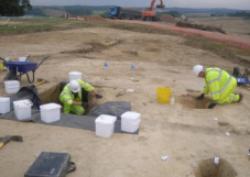 Bexhill - Archaeology enthusiasts working along the route of the Hastings-Bexhill Link Road have helped unearth what is thought to be one of the most significant finds of prehistoric remains in the country. Working alongside Oxford Archaeology, members of the Hastings Area Archaeological Research Group (HAARG) have been involved in the excavation of Mesolithic flint scatters from the site. At the eastern end of the link road, near Upper Wilting Farm, the team has uncovered evidence of Early Romano British industry and Saxon Settlement activity. The main focus of Oxford Archaeology’s work in this area has been the excavation of a large iron working site with up to 17 iron smelting furnaces and evidence of associated activities.
Bexhill - Archaeology enthusiasts working along the route of the Hastings-Bexhill Link Road have helped unearth what is thought to be one of the most significant finds of prehistoric remains in the country. Working alongside Oxford Archaeology, members of the Hastings Area Archaeological Research Group (HAARG) have been involved in the excavation of Mesolithic flint scatters from the site. At the eastern end of the link road, near Upper Wilting Farm, the team has uncovered evidence of Early Romano British industry and Saxon Settlement activity. The main focus of Oxford Archaeology’s work in this area has been the excavation of a large iron working site with up to 17 iron smelting furnaces and evidence of associated activities.
http://www.sussexexpress.co.uk/news/county-news/prehistoric-artefacts-found-on-road-site-1-6376631
ITALIE – 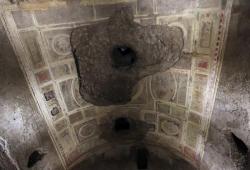
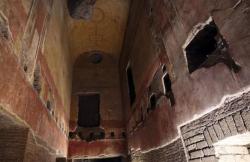 Rome - The golden palace that the Emperor Nero built as a monument to himself after half of ancient Rome was consumed by fire is reopening to the public even though its renovation isn't finished yet.The main palace of the "Domus Aurea" or "House of Gold" complex, which once included an artificial lake where the Colosseum now stands, was closed in 2005 for emergency repairs and briefly reopened in 2007 before closing again. Caring for thousands of years worth of decaying art and architecture is a perennial problem in Italy. The Domus Aurea is particularly hard to maintain because the later emperor Trajan filled it with rubble and built his own baths on top.The Domus Aurea, so named because of the gold leaf covering some of its walls, was said to have contained a 120-foot (36.6 meter) statue of Nero. It was rediscovered in the 15th century. Renaissance painters including Raphael and Michelangelo lowered themselves on ropes through holes in the ceiling to study the palace's frescoes, which are now at risk from humidity levels that reach 90 percent.
Rome - The golden palace that the Emperor Nero built as a monument to himself after half of ancient Rome was consumed by fire is reopening to the public even though its renovation isn't finished yet.The main palace of the "Domus Aurea" or "House of Gold" complex, which once included an artificial lake where the Colosseum now stands, was closed in 2005 for emergency repairs and briefly reopened in 2007 before closing again. Caring for thousands of years worth of decaying art and architecture is a perennial problem in Italy. The Domus Aurea is particularly hard to maintain because the later emperor Trajan filled it with rubble and built his own baths on top.The Domus Aurea, so named because of the gold leaf covering some of its walls, was said to have contained a 120-foot (36.6 meter) statue of Nero. It was rediscovered in the 15th century. Renaissance painters including Raphael and Michelangelo lowered themselves on ropes through holes in the ceiling to study the palace's frescoes, which are now at risk from humidity levels that reach 90 percent.
http://uk.reuters.com/article/2014/10/24/us-italy-palace-idUKKCN0ID1WJ20141024?rpc=401
USA – 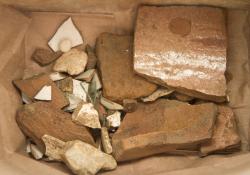 Portland - Archaeologists are unearthing shards of dishes from the Revolutionary War era at the Tate House Museum this fall. So far they have found pieces of salt-glazed stoneware from the 1750s, bits of creamware from the 1760s and pearlware from the 1780s as they shift through the soils surrounding the historic Georgian townhouse in the Stroudwater section of Portland. But the big mystery so far is a flat, round, white piece of porcelain with tiny brass gears that emerged from the site. Crane, the head archaeologist for the project, said she plans to take the object to a clockmaker to see if it could have been part of a timepiece. The project was triggered by a leaky basement at the Tate House, built in 1755 to house Capt. George Tate, the senior mast agent for the British Royal Navy, and his family. The home overlooked the mast yard on the Fore River where white pines from Maine were cut and shipped to England. All white pines over 24 inches in diameter were the property of the king and were marked with the sign of a broad arrow, which along with the tax on tea, symbolized the tyranny of the British Crown in the Colonies. The archaeologists were called in to study the soils around the house before repair work starts to fix the drainage system, which Crane described as a spaghetti system of drains that funnel water into the basement instead of away from it.
Portland - Archaeologists are unearthing shards of dishes from the Revolutionary War era at the Tate House Museum this fall. So far they have found pieces of salt-glazed stoneware from the 1750s, bits of creamware from the 1760s and pearlware from the 1780s as they shift through the soils surrounding the historic Georgian townhouse in the Stroudwater section of Portland. But the big mystery so far is a flat, round, white piece of porcelain with tiny brass gears that emerged from the site. Crane, the head archaeologist for the project, said she plans to take the object to a clockmaker to see if it could have been part of a timepiece. The project was triggered by a leaky basement at the Tate House, built in 1755 to house Capt. George Tate, the senior mast agent for the British Royal Navy, and his family. The home overlooked the mast yard on the Fore River where white pines from Maine were cut and shipped to England. All white pines over 24 inches in diameter were the property of the king and were marked with the sign of a broad arrow, which along with the tax on tea, symbolized the tyranny of the British Crown in the Colonies. The archaeologists were called in to study the soils around the house before repair work starts to fix the drainage system, which Crane described as a spaghetti system of drains that funnel water into the basement instead of away from it.
http://www.pressherald.com/2014/10/25/shards-of-old-dishes-unearthed-at-tate-house-museum/
INDE – Damroo - Archaeological excavations at Damroo, a mud fort site, has yielded age-old terracotta seals that bears information about rulers from 1st century AD to 5th century AD—throwing light on 500 years of missing link of ancient political history of Dakshin Kosla, now known as Chhattisgarh. "Discovery of a number of terracotta inscribed sealing's from stratified layers this season provides details on pre-Satvahna and Gupta period. Decipherments of inscribed sealings have been attested by Mysore-based Epigraphy branch of Archaeological Survey of India (ASI)," says Dr Shivakant Bajpai, archaeological officer, leading excavation at Damroo site. He told, TOI that an important circular terracotta sealing bearing legend Jamdasya along with auspicious swastika symbol in early Brahmi character, may be assigned to Sunga period. Located in Balodabazar-Bhatapara district, about 96 Kms from the state capital, Damroo is an important hinterland township settlement in central India. First mud fort site being excavated by state department of culture and archaeology, lies about 4.5 kilometres from confluence of Sheonath or Shivnath river and its tributary Khorsi nallah. Bajpai said "Evidences of Satvahna and Magha rulers has come in form of sealing bearing the legend "Rayon Achantdasas youge" in character of 1st-2nd century Brahmi. This Brhami inscription around the central monogram of Malhar symbol is denoted by Brahmi character Ma or developed Nandipada, while some scholars referred it as synonyms for Malhar or Mallaripattan." He said excavations at Damroo threw light on the Satvahana and Magha settlements in the South Kosala. "A good number of terracotta sealings in early Brahmi character including typical box headed are traced from excavation which pertains to Gupta-Vakatak period. The box headed Brahmi epigraphs are commonly available in the region", he added.Elaborating on the findings, Bajpai said earliest reference of this region and king found in Prayag prashasti of Samudragupta, Allahabad pillar Inscription as Kosalak Mahendra. He said scholars believed that this Kosal is South Kosala and Mahendra was the king of this Kosala. Pointing out that it would also be interesting to know how and when this region was established as South Kosala in the absence of early archaeological evidence, Bajpai said but it is unanimously accepted that it was a part of Kosal Mahajanpada and was known as Dakshin Kosala. He said terracotta sealings, discovered at Damroo, have name of rulers hitherto unknown Maharaj Kumar Shri Dharasya. Maharaj Rudrasya, Maharaj Kumar Shri Mattrasya, Sadama Shri [Shri Damasya] and Maharaj Shri Darasya.
http://timesofindia.indiatimes.com/city/raipur/Seals-dating-to-1st-century-AD-found-at-Damroo-site/articleshow/44928904.cms
USA – 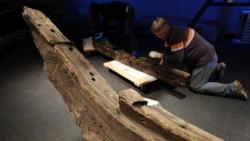 Austin - A frigate carrying French colonists to the New World that sank in a storm off the Texas coast more than 300 years ago is being reassembled into a display that archeologists hope will let people walk over the hull and feel like they are on the ship's deck. The 1686 wreck of the 54-foot oak frigate La Belle — in an expedition led by famed Mississippi River explorer Rene-Robert Cavelier Sieur de La Salle — is blamed for dooming France's further exploration of what would become Texas and the American Southwest. But La Salle's short-lived Fort St. Louis near the shipwreck site in Matagorda Bay, about 100 miles southwest of present-day Houston, also convinced Spain to boost its presence in the region to ward off a feared French territorial expansion. Beginning Saturday, visitors to the Austin museum will be able to watch Bruseth and other archaeologists put the wrecked ship back together and talk with them as they work. The reassembly is expected to be complete by spring.
Austin - A frigate carrying French colonists to the New World that sank in a storm off the Texas coast more than 300 years ago is being reassembled into a display that archeologists hope will let people walk over the hull and feel like they are on the ship's deck. The 1686 wreck of the 54-foot oak frigate La Belle — in an expedition led by famed Mississippi River explorer Rene-Robert Cavelier Sieur de La Salle — is blamed for dooming France's further exploration of what would become Texas and the American Southwest. But La Salle's short-lived Fort St. Louis near the shipwreck site in Matagorda Bay, about 100 miles southwest of present-day Houston, also convinced Spain to boost its presence in the region to ward off a feared French territorial expansion. Beginning Saturday, visitors to the Austin museum will be able to watch Bruseth and other archaeologists put the wrecked ship back together and talk with them as they work. The reassembly is expected to be complete by spring.
http://www.timescolonist.com/remains-of-300-year-old-shipwreck-loss-of-which-doomed-the-french-in-texas-being-reassembled-1.1465132
INDE - Kallumadi - Carrying the grandeur of the classical architectural prowess of the glorious Vijayanagara period, the Chennakesava Swamy temple still stands tall at Kallumadi village of Singanamala mandal in Anantapur district. Built between the 14th and 16th century, the temple is gradually losing its sheen, thanks to the apathy of the government. The utter negligence in the upkeep of the temple is evident from the fact that even the presiding deity here has been left to the mercy of the vagaries of nature. The abundant shrines of Chennakesava Swamy, dotting the entire Rayalaseema region, even extending up to Prakasam district, stands testimony to the reverence the people of the region have for the deity. Particularly, this temple, albeit can’t be conclusively dated back to a specific period, its architectural style is suggestive of the Vijayanagara period, according to the Archaeology and Museums Department. The temple, a stone structure built out of seven layers of huge rocks stacked one over the other on all sides, features the range of Vijayanagara temple architecture-- Garbha Griha (sanctum sanctorum), ante-room and an outer mandapa (hall) - except for the Rayagopura. The temple also suggests advancement in the construction of architectural adornments on the gopuram, inner walls, facade and alley pillars. The sculptures on hard granite stones are replaced to a great extent by artistic forms of animals and deities depicting Puranas. Made out of lime mortar, they are attached to the stone with astounding precision and stability, staying true to the style of heavy adornment of the shrine that used to be followed in the Vijayanagara temple architecture.
http://www.thehindu.com/news/national/andhra-pradesh/an-architectural-ensemble-in-a-shambles/article6535451.ece?textsize=large&test=1